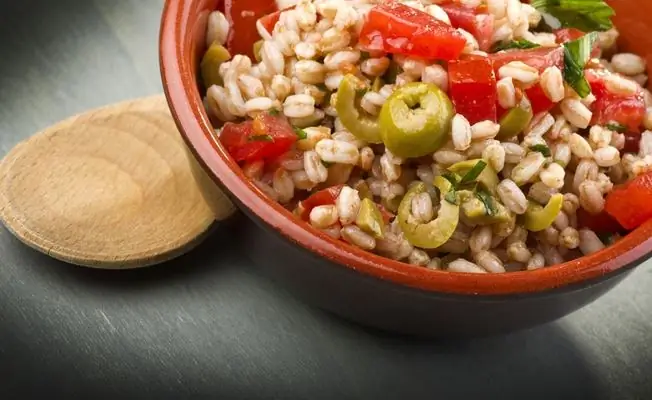- Author Brandon Turner [email protected].
- Public 2023-12-17 01:37.
- Last modified 2025-06-01 06:36.
If in Ancient Russia spelled porridge was present on the table of peasants every day, today this unpretentious dish is equivalent to exoticism. It is not possible to buy spelled grain in every store, but Russians' interest in this grain is definitely growing. And nutritionists are calling for the return of forgotten porridge to the diet of those who care about weight loss, quick recovery from illness, and the full growth and development of their children.

The history of growing spelled, the progenitor of modern wheat in Russia, goes back to the 10th century, and in the Mediterranean it was cultivated as far back as the 5th century BC. Unfortunately, in the pursuit of high yields, this unpretentious cereal was completely ousted from the territory of Russian fields in the middle of the 20th century. But fortunately, they remembered about it today, when for many people the issue of healthy natural nutrition has become especially acute.
Chemical composition and technological properties of spelled
Interest in spelled is not accidental. Indeed, according to the Institute of Nutrition of the Russian Academy of Medical Sciences, which studied the diet of the large population of Russia, if food meets the requirements of calorie content, it is completely unbalanced in terms of the main components. This fact is not in favor of maintaining the health of school-age children, as well as people engaged in hard physical labor. The value of cereal crops is that they are a source of cheap vegetable protein, the amount of which in some spelled varieties reaches 37%.
However, essential amino acids deserve even more attention, since the human body does not produce them on its own. If the protein of cereals belongs to the category of inferior ones, since its composition is limited by the number of amino acids (even in buckwheat there are only 8 of them), then the biological value of spelled is determined by 18 essential amino acids and an almost complete list of B vitamins. substances, and flour from it does not lose its useful properties even with the smallest grinding, which cannot be said about modern wheat varieties.
True, the technological features of spelled flour do not allow it to be used as the main ingredient for bread. Such bread cannot be stored for a long time, like flour itself. But adding spelled flour to wheat flour gives the bread great value. Spelled contains much less carbohydrates, and micro- and macroelements are in a balanced state and are easily absorbed by the human body. Due to the dense film, spelled contains more silicon. Of all types of wheat, it is the leader in fiber. This is what allows spelled to have a beneficial effect on the cardiovascular system and resist the formation of tumors.
How to cook spelled porridge
The only drawback of spelled has always been its low yield and difficulty in processing. The flower and spikelet scales grow so tightly to the grain that it is very difficult to thresh clean grain. However, today, when polished parboiled spelled grain has appeared on the shelves of large supermarkets, it is simply unreasonable not to take the chance to cook some healthy dish out of it. It is a pity that the recipe is very limited. In ancient Russia, they mainly cooked porridge from ripened and unripe spelled (green). The latter was prepared from unrefined grain.
In Caucasian cuisine, spelled is still present, which is added to soups and pilaf is made from it. In Italy, it is used to make risotto. It is unlikely that it will be possible to cook a viscous messy porridge from hard grain spelled, but friable is tasty and fragrant. Only even from steamed grain porridge will cook for a long time, about 40 minutes. In the recipe for spelled porridge "in the old Russian way" it is recommended to pour spelled over the whole night with a mixture of curdled milk and spring water. In the morning, the grain is washed and cooked in milk in a 1: 2 ratio until tender. Cooking spelled does not tolerate haste. Even after readiness, the pot of porridge should be wrapped or covered with a pillow and allowed to brew for at least another half hour.
Some experienced culinary experts believe that cooking spelled in milk is inappropriate, since this does not in any way increase its balanced composition and does not particularly affect the improvement of taste. As a rule, for 1 part of spelled, 2-2, 4 parts of water are taken. First, bring the water to a boil, add salt, butter, sugar (optional) to it, and only then add the washed grain. As mentioned above, cooking will take 40-50 minutes, after which it is important to darken the finished dish. Cooking spelled in a pot is encouraged, when, after turning off the fire, it remains in the oven for a long time. Spelled goes well with meat ingredients, so it can be used as a side dish for fish and meat.
Gourmets believe that spelled porridge surpasses wheat and pearl barley in taste and aroma, and oats, barley and rice in nutritional value. Scientists are unanimous in the opinion that in terms of productivity and quality it should be compared not with a relative of wheat, but with millet or buckwheat. Although in terms of balance and digestibility, spelled is superior to all known cereal crops.






